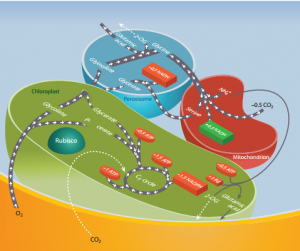DOI: 10.1146/annurev-arplant-043015-111709
The costs of photorespiration to food production now and in the future
Abstract
 Photorespiration is essential for C3 plants but operates at the massive expense of fixed carbon dioxide and energy. Photorespiration is initiated when the initial enzyme of photosynthesis, ribulose-1,5-bisphosphate carboxylase/oxygenase (Rubisco), reacts with oxygen instead of carbon dioxide and produces a toxic compound that is then recycled by photorespiration. Photorespiration can be modeled at the canopy and regional scales to determine its cost under current and future atmospheres. A regional-scale model reveals that photorespiration currently decreases US soybean and wheat yields by 36% and 20%, respectively, and a 5% decrease in the losses due to photorespiration would be worth approximately $500 million annually in the United States. Furthermore, photorespiration will continue to impact yield under future climates despite increases in carbon dioxide, with models suggesting a 12–55% improvement in gross photosynthesis in the absence of photorespiration, even under climate change scenarios predicting the largest increases in atmospheric carbon dioxide concentration. Although photorespiration is tied to other important metabolic functions, the benefit of improving its efficiency appears to outweigh any potential secondary disadvantages.
Photorespiration is essential for C3 plants but operates at the massive expense of fixed carbon dioxide and energy. Photorespiration is initiated when the initial enzyme of photosynthesis, ribulose-1,5-bisphosphate carboxylase/oxygenase (Rubisco), reacts with oxygen instead of carbon dioxide and produces a toxic compound that is then recycled by photorespiration. Photorespiration can be modeled at the canopy and regional scales to determine its cost under current and future atmospheres. A regional-scale model reveals that photorespiration currently decreases US soybean and wheat yields by 36% and 20%, respectively, and a 5% decrease in the losses due to photorespiration would be worth approximately $500 million annually in the United States. Furthermore, photorespiration will continue to impact yield under future climates despite increases in carbon dioxide, with models suggesting a 12–55% improvement in gross photosynthesis in the absence of photorespiration, even under climate change scenarios predicting the largest increases in atmospheric carbon dioxide concentration. Although photorespiration is tied to other important metabolic functions, the benefit of improving its efficiency appears to outweigh any potential secondary disadvantages.
